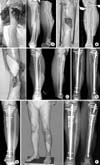Abstract
Purpose
The purpose of this study is to evaluate the outcome of treatment for patients with Type IIIb open tibial fractures.
Materials and Methods
This study targeted 35 adult patients for whom follow-up was possible over one year after undergoing surgical treatment. There were 29 males and six females with an average age of 45 years.
Results
Fracture location was proximal in 10 cases, midshaft in 13 cases, and the distal part of the tibia in 12 cases. An average of 10 days was observed for definitive fixation with soft tissue coverage of the injury. The mean time to radiographic union was 27 weeks. Sixteen cases (45.7%) of complications were observed. Three cases of superficial infection, two cases of deep infection, four cases of partial flap necrosis, three cases of mal-alignment, three cases of joint stiffness, and one case of hardware breakage were observed. The mean lower extremity functional scale score was 68.5 and the factors influencing the clinical results were severity of open wound (p=0.000) and occurrence of complications (p=0.000) according to results of multiple regression analysis.
Figures and Tables
 | Fig. 1
(A) A 65-year-old man sustained a type IIIb open tibia segmented fracture. (B) The vacuum-assisted closure system was applied to the open wound after debridement and temporary external fixation and provisional plate fixation. (C) An unreamed tibial nail was applied with an antero-lateral thigh free flap at 12 days after injury. (D) No visible callus on the proximal segmented area was observed at two months after surgery. (E) Plate augmentation without bone graft. (F) Clinical photograph shows a successful result 14 months after injury and the fracture was healed without complication. |
References
1. Court-Brown CM, Rimmer S, Prakash U, McQueen MM. The epidemiology of open long bone fractures. Injury. 1998; 29:529–534.

2. DeFranzo AJ, Argenta LC, Marks MW, et al. The use of vacuum-assisted closure therapy for the treatment of lower-extremity wounds with exposed bone. Plast Reconstr Surg. 2001; 108:1184–1191.

3. Melvin JS, Dombroski DG, Torbert JT, Kovach SJ, Esterhai JL, Mehta S. Open tibial shaft fractures: I. Evaluation and initial wound management. J Am Acad Orthop Surg. 2010; 18:10–19.

4. Melvin JS, Dombroski DG, Torbert JT, Kovach SJ, Esterhai JL, Mehta S. Open tibial shaft fractures: II. Definitive management and limb salvage. J Am Acad Orthop Surg. 2010; 18:108–117.

5. Olson SA, Schemitsch EH. Open fractures of the tibial shaft: an update. Instr Course Lect. 2003; 52:623–631.
6. Gustilo RB, Anderson JT. Prevention of infection in the treatment of one thousand and twenty-five open fractures of long bones: retrospective and prospective analyses. J Bone Joint Surg Am. 1976; 58:453–458.

7. Sarmiento A, Sobol PA, Sew Hoy AL, Ross SD, Racette WL, Tarr RR. Prefabricated functional braces for the treatment of fractures of the tibial diaphysis. J Bone Joint Surg Am. 1984; 66:1328–1339.

8. Milner SA. A more accurate method of measurement of angulation after fractures of the tibia. J Bone Joint Surg Br. 1997; 79:972–974.

9. Sohn OJ, Kang DH. Staged protocol in treatment of open distal tibia fracture: using lateral MIPO. Clin Orthop Surg. 2011; 3:69–76.

10. Binkley JM, Stratford PW, Lott SA, Riddle DL. North American Orthopaedic Rehabilitation Research Network. The Lower Extremity Functional Scale (LEFS): scale development, measurement properties, and clinical application. Phys Ther. 1999; 79:371–383.
11. Kang CN, Kim JO, Kim DW, et al. Treatment of type IIIB open tibial shaft fractures. J Korean Soc Fract. 1998; 11:560–566.

12. Oh JK, Oh CW, Roh KJ, Chung DM. Treatment of open tibial shaft fractures using unreamed nailing. J Korean Fract Soc. 2005; 18:22–28.

13. Park KC. Acute management of soft tissue defect in open fracture. J Korean Fract Soc. 2010; 23:155–159.

14. Templeman DC, Gulli B, Tsukayama DT, Gustilo RB. Update on the management of open fractures of the tibial shaft. Clin Orthop Relat Res. 1998; (350):18–25.

15. Godina M. Early microsurgical reconstruction of complex trauma of the extremities. Plast Reconstr Surg. 1986; 78:285–292.

16. Gopal S, Majumder S, Batchelor AG, Knight SL, De Boer P, Smith RM. Fix and flap: the radical orthopaedic and plastic treatment of severe open fractures of the tibia. J Bone Joint Surg Br. 2000; 82:959–966.

17. D'Alleyrand JC, Manson TT, Dancy L, et al. Is time to flap coverage of open tibial fractures an independent predictor of flap-related complications? J Orthop Trauma. 2014; 28:288–293.
18. Dedmond BT, Kortesis B, Punger K, et al. The use of negative-pressure wound therapy (NPWT) in the temporary treatment of soft-tissue injuries associated with high-energy open tibial shaft fractures. J Orthop Trauma. 2007; 21:11–17.

19. Gustilo RB, Mendoza RM, Williams DN. Problems in the management of type III (severe) open fractures: a new classification of type III open fractures. J Trauma. 1984; 24:742–746.
20. Naique SB, Pearse M, Nanchahal J. Management of severe open tibial fractures: the need for combined orthopaedic and plastic surgical treatment in specialist centres. J Bone Joint Surg Br. 2006; 88:351–357.




 PDF
PDF ePub
ePub Citation
Citation Print
Print




 XML Download
XML Download